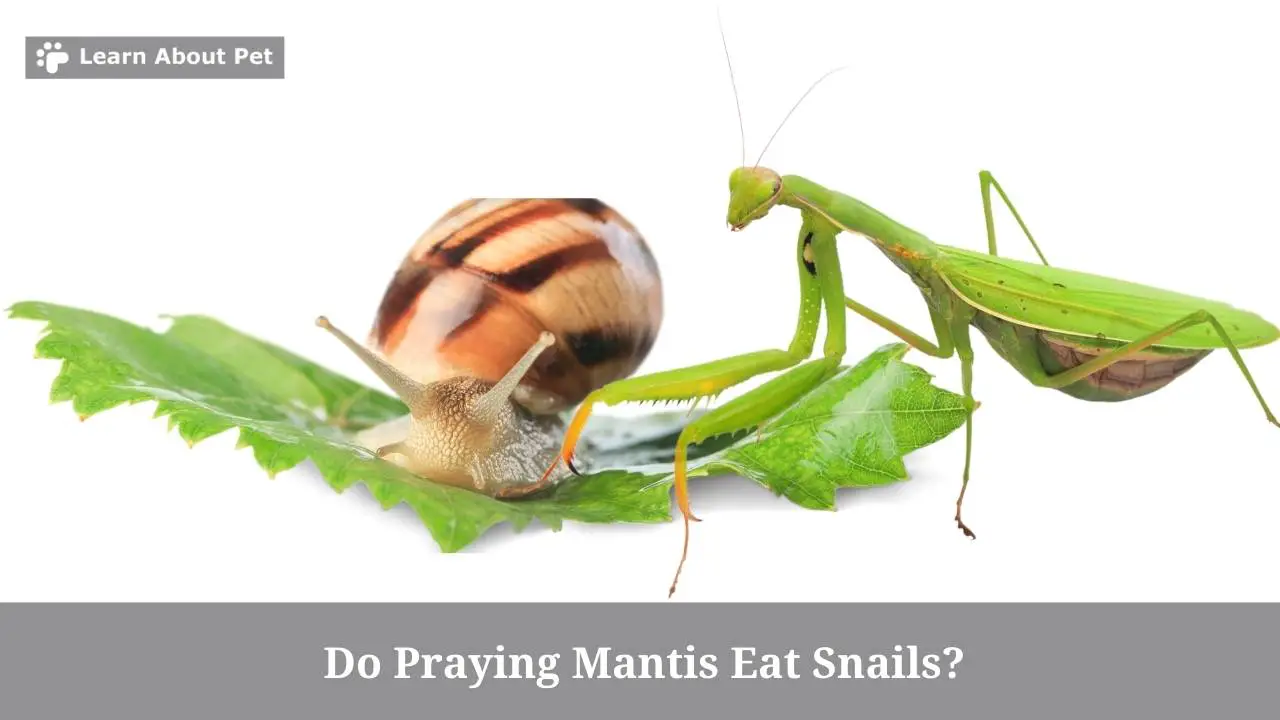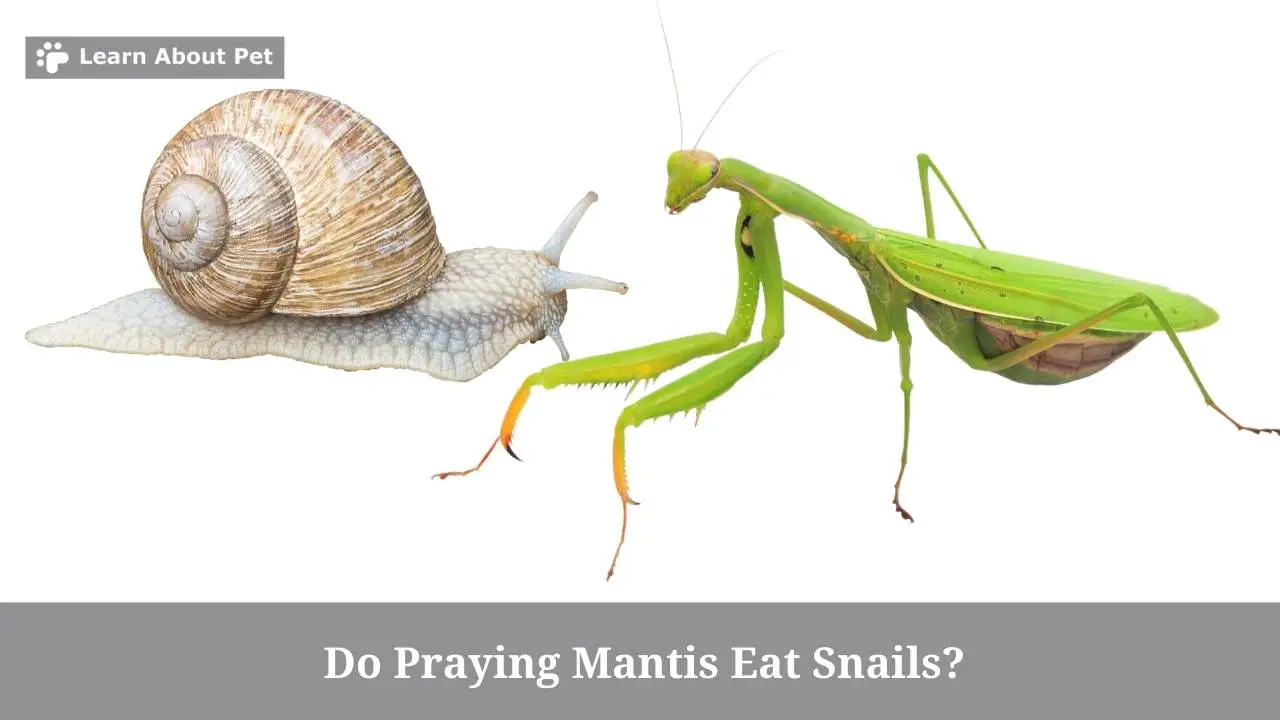Praying mantises are said to be capable of eating a wide range of things. But can they actually eat snails? And if one keeps a pet praying mantis, is it possible to feed it on snails? This article has the answers.
Do praying mantis eat snails? Yes, praying mantis are capable of hunting for and eating snails, especially the smaller ones. This means that praying mantises can help in biological control of pest snails. It also means that people who keep pet praying mantises can occasionally give them snails as food.
However, it is important to note that in the list of ‘preferred foods’ for praying mantises, snails (alongside slugs) are likely to be somewhere near the bottom.

Thus while praying mantises can in principle eat snails, they may nonetheless decline the snails at times – if other ‘better’ food is available.
Can Praying Mantis Kill Snails?
Yes, praying mantises have the ability to kill snails, especially the smaller ones.
Praying mantises are equipped with strong and highly dexterous forelimbs, with which they are able to kill relatively tough creatures. That includes the snails in question here.
Can Praying Mantis Eat Snails?
Yes, praying mantises are capable of eating snails.
Credible reports abound of people who have found praying mantises eating snails. Therefore eating a snail is something that is well within a praying mantis’ capability.
But eating snails is generally not something praying mantises do routinely. If one asks, do praying mantis eat snails daily, the answer is usually ‘no’.
Thus while the praying mantis have the ability to eat snails, it is an ability they tend to use sparingly. Only once in a while is someone likely to find a praying mantis eating a snail: even within snail-rich ecosystems.
How Does Praying Mantis Eat Snails?
The praying mantis tends to catch and crush the snails using its forelimbs, and then eat them in bits.
To catch the snails, the mantis relies mostly on its ability to blend in with its surroundings. The color and the shape of the mantis make it blend in very well.
With the mantis well-blended in the environment, a snail will inch very close to it (not realizing it’s a predator).
Once the mantis senses that the snail is close enough, it just extends its powerful forelimb to catch it.
After catching the snail, the next step for the mantis is to immobilize it. This it does by squeezing it using its powerful forelimb again.
Thereafter, the mantis dismembers the snail, eating it bit by bit, until it is full.
Which Types Of Snails Do Praying Mantis Eat?
It is possible for snails to be in various states: live, dead, cooked, frozen… and so on.
The question before us is on which of those states the mantis eat the snails in. Let’s find out.
Do Praying Mantis Eat Live Snails?
Yes, praying mantis prefer to eat live snails. In fact, praying mantis can only eat live snails: not snails in any other state.
Thus if you want to give a pet mantis snails to eat, you have to ensure that the mantis gets them while they are alive.

Do Praying Mantis Eat Dead Snails?
No, praying mantis normally won’t eat dead snails. The mantis will only eat a snail if it is the one that kills the snail. Not if it finds the snail already dead.
Thus if you present a pet mantis with a dead snail, the mantis could just ignore it. That would be normal mantis behavior.
Do Praying Mantis Eat Cooked Snails?
No, praying mantises are normally not capable of eating cooked snails. If the snails are cooked, it means that they are dead. And as we saw earlier, mantises can’t eat dead snails.
That is why, by extension, praying mantis can’t eat cooked snails.
How Often Will Praying Mantis Eat Snails?
Praying mantises only eat snails once in a while. As mentioned earlier, the snails (alongside their cousins slugs) are not really foods that praying mantises like to eat.
Thus even when placed in a snail-rich ecosystem, a mantis tends to show reluctance. That is reluctance when it comes to hunting and eating the snails. Normally, the mantis will only get to eat the snails on an occasional basis.
How Much Snails Can Praying Mantis Eat?
Snails tend to vary considerably in size. Praying mantises normally only eat the smaller ones. But compared to the insects that mantises normally eat, even those ‘small’ snails are still relatively big.
Consequently, one or two small snails are the most that a mantis will eat.
With regard to how much snails is too much for praying mantis, that would normally be anything that exceeds two small snails.
Final Verdict – Do Praying Mantis Eat Snails
Praying mantis do eat snails.
When hunting for snails, praying mantises try to blend in with their surroundings. Then the snails, unaware of the mantises’ presence, inch closer: until they are within the mantises’ striking distance.
Once the snails are reasonably close, the mantises just lurch forward, grab the snails using their forearms and squeeze them to immobile them.
Thereafter, the mantis dismember and eat the snails in bits.

If you find reasonably small live snails, you can try giving them to your mantis – to see if it will eat them.
But note that mantises seem to dislike foods like snails and slugs. Therefore don’t take offense if your pet praying mantis happens to decline any snails you offer it as food.
As a pet lover, make sure to learn about pet more and give your pet mantis a good and comfortable life!

Welcome to Learn About Pet. My name is Rajkumar Ravichandran and I love all pets, travel, and amazing food. I write about my passion and personal experience caring for multiple pets in this blog! ❤️
Post Disclaimer
DISCLAIMER: THIS BLOG OR WEBSITE, "Learn About Pet", DOES NOT PROVIDE YOU WITH MEDICAL ADVICE AND IS NOT A SUBSTITUTE FOR MEDICAL ADVICE. ALWAYS GET IN TOUCH WITH YOUR PERSONAL VETERINARIAN AND USE INFORMATION HERE AS GENERAL ADVICE.
The information, including but not limited to, text, graphics, images and other material contained on this website are for informational purposes only. No material on this site is intended to be a substitute for professional veterinary advice, food recommendation, diagnosis, or treatment. Always seek the advice of your veterinarian or other qualified health care provider with any questions you may have regarding a medical condition or for pet food related questions.







